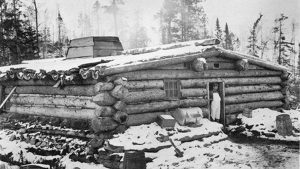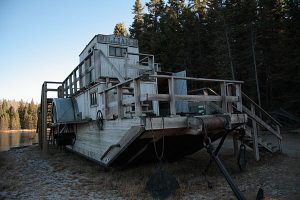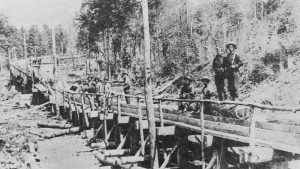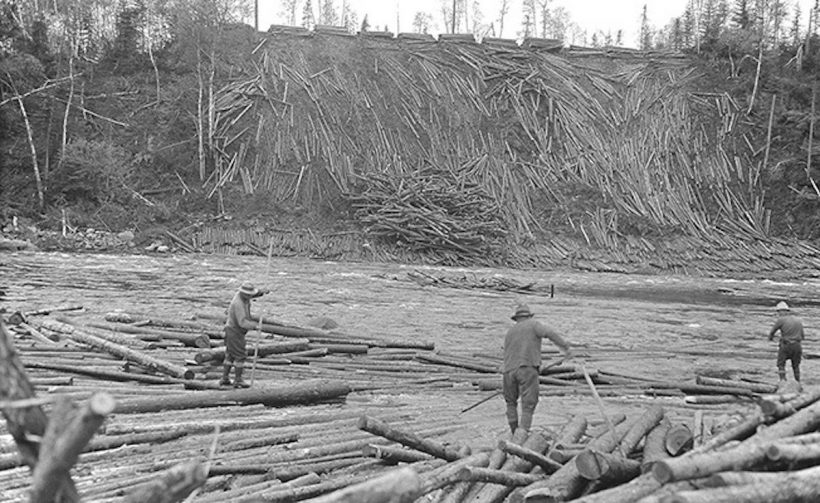THE LONG DRIVE by Ralph Bice Wednesday, September 4, 1974
In most all of the stories about Algonquin Park mention is made of the famous and unusual log drive when the Gilmore (Gilmour – Ed.) Lumber Company drove pine logs all the way from their limits in said Park to their sawmill at Trenton. The operation was a costly one but the length of the drive, meaning the distance from the standing timber to the sawmill, made it the topic for conversation for many years when the subject of log drives was mentioned.
This could not be considered the greatest distance logs have been taken by water to a mill. Just about that same time an American company had cutting rights to a tract of timber in Butt Township in Nipissing District. These logs, and many of them large ones, were driven all the way down the Magnetawan River to Byng Inlet, then boomed and towed to Bay City, Michigan. I saw a record where it stated that on one of the drives the logs averaged a bit over five hundred board feet per log. Even with the log rule used in those days it meant for quite large logs. But we were supposed to be writing about the drive to Trenton.
What did make this drive unusual was that logs were taken on three different waterways. Since the headquarters was at Canoe Lake and the camps in that area it meant that the first river was the Oxtongue. Next would come the Black River and finally the Gull River waters the rest of the way to Trenton.
My father worked in one of the camps the first winter, in fact the first two winters. The camp he was in was built right beside where the dam is at the foot of Joe Lake. Gilmore’s (Gilmour’s) had a reserve dam there when they were cutting logs and it was still standing when I was there first in 1914. At that time too the foundations of the old camps were easily distinguished as they had not all rotted away.
I should have mentioned the great numbers of pine trees that were there. When I was first there fires had burned away the slash and the new growth had not hidden the stumps and what a pine forest it must have been! Dad has told us several times that in the two winters he worked there they did not get far enough from the camp to make it necessary to carry a lunch. Easier to walk back to camp. Too, I have been told that this was one of the first operations where they did not use oxen. Only horses.
For quite a few years after I began to work in the Park the old camps were still standing. Believe there were eleven camps in all and these were grouped in an area that now would be handled by perhaps only one. But apparently the men in charge wanted plenty of logs so plenty of camps.

The foreman in the camp where Dad worked was Con O’Donnell who later lived in Kearney and I went to school with his children. I do not believe he followed the drive though his brother Martin O’Donnell was one of the men in charge of the drive.
Besides O’Donnell my father remembered Joe and Hugh McCormick, John Hicky, Joe Cox, Jim Chambers, Ed Casijean and Sam Gunther, a son of the Walking Boss, P.M. Gunther. Ed Cassidy was head man in charge of the drive. Many will remember Ed. He had a service station just north or east of the swing bridge in Huntsville and for a number of years was a fur buyer.
Logs were cut in the woods much later in the spring then than is now done. No doubt because of the short haul to water. Many of the men stayed in camp after cutting finished as it was a long way home and the drive would start as soon as the weather and ice permitted. A thaw did come fairly early but cold weather returned and it looked like the spring flood would get away before the lakes were clear of ice. So, as a matter of necessity, the ice on Potter Lake was dynamited so the logs could get started on their long journey. The date he gave me was April 28th but I am not certain if this is the date of the blasting of the ice or when the logs started to move. Whichever it was the water would still be cold and since the creek from Potter Lake to Canoe Lake was too small for a boat it would mean a lot of wading.
At Canoe Lake the drive merged with the logs coming down from Joe Lake and at Tea Lake with the logs from Smoke Lake. The rest of the drive to Lake of Bays and Dorset was uneventful.
A mile south of Dorset the lumber company had built an endless chain, something in the same style as the jack ladder used on many mills to lift logs from the water into the mill. From the top of the hill the logs went in a trough for a mile, and then an endless chain put the logs into Raven Lake and into the Black River and on into Hollow Lake. Hollow Lake was dammed to raise the water and a trench dug in one of the lower spots so water and logs could go through a swamp to Harvey’s Marsh and a canal dug from there to St. Norah’s Lake. The rest of the way was all Gull River waters.
The drive only got as far as Healy Falls, near Campbellford and stopped on October 1st. Dad also worked in the camps and on the drive the second year but while they had the experience of the first year to help, water was bad, and the drive stopped on October 13th at Lakefield. This was a bad year as they had a heavy fall of snow, twenty-two inches, at Fenelon Falls early in October and the men often worked in frozen clothes.
Dad mentioned that there was good food and plenty of it. Most of the way the cook camp must have been built on a raft or crib.

The man in charge of the alligator, or steam scow, was named Puffer. These craft could tow themselves across land, if necessary, to the next navigable water. The top wages was $28.00 per month, which included board.
Apparently there was a third cut and a third drive in which my father did not take part and this drive did make Rice Lake the first year. But in the three drives no logs reached the mill the first year.
Just about that time the Canada Atlantic Railroad was built by J.R. Booth, the famous lumberman, and Gilmour’s built a sawmill at Canoe Lake. But this too was costly as it was over a mile from the railroad and a long siding had to be built. Then it was discovered that the quality of the pine was not good. Rot had begun to show in most of the trees and that meant for low-grade lumber. With the heavy operating cost returns did not allow for producing low-grade lumber and operations ceased early in this century.
When I first worked in the Park in 1914 there was still a lot of talk about the wasted pine lumber and how three-inch boards called ‘deal’ had been used to fill in wet places in order to pile lumber. Hard to understand why the pine would be such poor quality. The Huntsville Lumber Company also used Canoe Lake as headquarters just a few years later and the logs they cut were driven to Huntsville. Much of the timber, instead of being poor quality was used for square timber and such timbers would only be accepted if they were number one pine.
At about that time the first lumbermen were cutting pine in Proudfoot Township and I have been told that the pine those early cutters took was about the finest that was found anywhere in Ontario. So it is hard to understand why the pine the Gilmour’s cut produced poor grade lumber.
I worked along the railroad east of Canoe Lake in the summer of 1914. There is a creek, not too large, that follows the R.R. or perhaps the R.R. followed the creek. The creek rises in a few marshy ponds perhaps two or three miles from Canoe Lake. This creek had been improved no doubt for a log drive as there were several dams, all with sluiceways. No one could tell me anything about any drive on that creek but it looked like the lumbermen in those days did not like to haul logs any distance if they could be transported by water.

Just a bit of humour in all this. On the first drive, my dad, who as twenty-one at the time, and some of his buddies around the same age discovered a nice apple orchard and since it was just about picking time they decided they should have some. Only thing, before they had really got started they met the owner who gave them quite a lecture about stealing apples and I believe even complained to the foreman. I never was told if there was a penalty.
Years later my father met a school teacher and they were married. But you can imagine my father’s surprise and perhaps embarrassment when he went to claim his bride at her father’s home to find that his future father-in-law was the same man who had given him such a hard time when he was caught stealing apples.
The dates and names I got from my father a few years before he died. Perhaps if I had thought of it years ago I might have been given more information. But it was quite an adventure going in from Dorset, no doubt staying at the half-way house at Hardwood Lake (walking) and next day making camp. All winter with only the same crew, balsam brush beds, ten hours a day, six days a week. Guess they made a better breed of men then. But in all the drives and other operations in the woods the Gilmour drive will have to be just about the most unusual in the history of logging.
